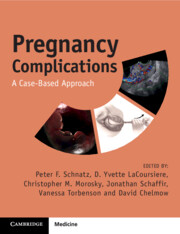Book contents
- Pregnancy Complications
- Pregnancy Complications
- Copyright page
- Contents
- Contributors
- Preface
- Note from the Editor-in-Chief
- Normal Laboratory Values (Conventional Units) []
- Section 1 Antepartum (Early Pregnancy)
- Section 2 Antepartum (Mid-trimester)
- Section 3 Antepartum (Late Pregnancy)
- Section 4 Antepartum (Medical Complications)
- Section 5 Antepartum (Infectious Complications)
- Section 6 Intrapartum/Delivery
- Section 7 Postpartum
- Section 8 Fetal Complications
- Section 9 Placental Complications
- Section 10 Complications of the Cord, Amnion, and Gravid Uterus
- Section 11 Psychosocial Considerations
- Case 90 A 40-Year-Old at 24 Weeks’ Gestation Presents with Food and Housing Insecurity
- Case 91 A 30-Year-Old at 25 Weeks’ Gestation Presents after a Fall with Back Pain and Bruising
- Case 92 A 25-Year-Old at 29 Weeks’ Gestation Presents with Opioid Use Disorder and Nausea, Vomiting, and Abdominal Pain
- Case 93 A 35-Year-Old Somali-Speaking Patient at 40 Weeks’ Gestation Presents in Active Labor with Her Husband as Her Interpreter
- Case 94 A 25-Year-Old Presents 1 Week after a Cesarean Delivery with Erratic Behavior
- Case 95 A 30-Year-Old Presents for a First Prenatal Visit with a Previous Emergency Operative Delivery Requesting a Planned Primary Cesarean
- Case 96 A 26-Year-Old Presents Late to Prenatal Care with Her Partner and Has a Flat Affect and Limited English Proficiency
- Case 97 A 25-Year-Old Primigravida with a History of Female Genital Mutilation
- Index
- References
Case 96 - A 26-Year-Old Presents Late to Prenatal Care with Her Partner and Has a Flat Affect and Limited English Proficiency
from Section 11 - Psychosocial Considerations
Published online by Cambridge University Press: 08 April 2025
- Pregnancy Complications
- Pregnancy Complications
- Copyright page
- Contents
- Contributors
- Preface
- Note from the Editor-in-Chief
- Normal Laboratory Values (Conventional Units) []
- Section 1 Antepartum (Early Pregnancy)
- Section 2 Antepartum (Mid-trimester)
- Section 3 Antepartum (Late Pregnancy)
- Section 4 Antepartum (Medical Complications)
- Section 5 Antepartum (Infectious Complications)
- Section 6 Intrapartum/Delivery
- Section 7 Postpartum
- Section 8 Fetal Complications
- Section 9 Placental Complications
- Section 10 Complications of the Cord, Amnion, and Gravid Uterus
- Section 11 Psychosocial Considerations
- Case 90 A 40-Year-Old at 24 Weeks’ Gestation Presents with Food and Housing Insecurity
- Case 91 A 30-Year-Old at 25 Weeks’ Gestation Presents after a Fall with Back Pain and Bruising
- Case 92 A 25-Year-Old at 29 Weeks’ Gestation Presents with Opioid Use Disorder and Nausea, Vomiting, and Abdominal Pain
- Case 93 A 35-Year-Old Somali-Speaking Patient at 40 Weeks’ Gestation Presents in Active Labor with Her Husband as Her Interpreter
- Case 94 A 25-Year-Old Presents 1 Week after a Cesarean Delivery with Erratic Behavior
- Case 95 A 30-Year-Old Presents for a First Prenatal Visit with a Previous Emergency Operative Delivery Requesting a Planned Primary Cesarean
- Case 96 A 26-Year-Old Presents Late to Prenatal Care with Her Partner and Has a Flat Affect and Limited English Proficiency
- Case 97 A 25-Year-Old Primigravida with a History of Female Genital Mutilation
- Index
- References
Summary
Human trafficking is an international problem that involves involuntary or forced labor. This can occur in a range of settings including sex work, agriculture, manufacturing, and hospitality. Patients may present in the gynecology office with sexually transmitted infections, pregnancy, mental health conditions, poor health or neglect, substance use disorders, and injuries. Providers should be familiar with red flags for trafficking and screen patients appropriately. With a positive screen, the patient’s safety needs to be immediately assessed. Trafficking can be reported to the National Human Trafficking Hotline. Providers should be aware of and follow local laws for reporting. Appropriate care should be provided to the patient based on presenting symptoms, including a history and physical exam, sexually transmitted infection testing, imaging, and mental health screenings as indicated. There are limited data regarding outcome of pregnancies in people who are trafficked. Care should be provided using trauma-informed principles.
- Type
- Chapter
- Information
- Pregnancy ComplicationsA Case-Based Approach, pp. 301 - 303Publisher: Cambridge University PressPrint publication year: 2025

